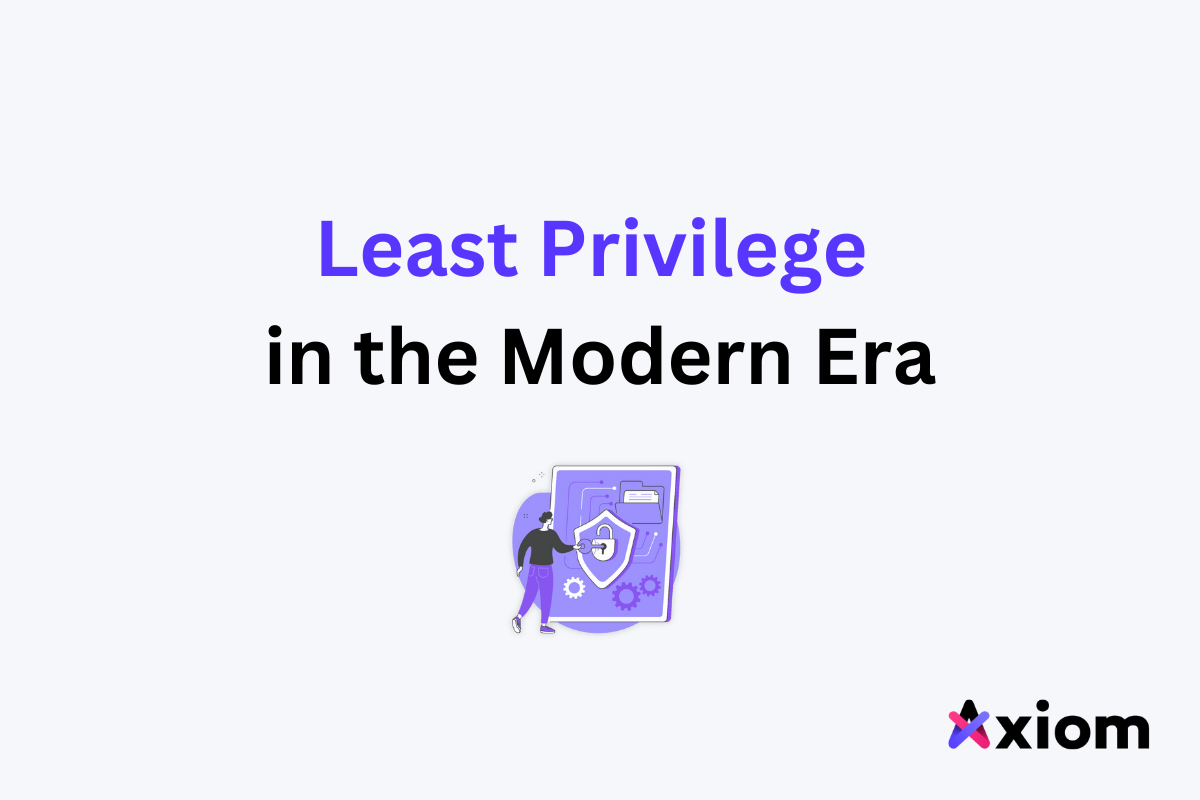Least privilege is a significant concept in the world of Identity and Access Management. This blog post introduces the concept, explains why it is so important, why least privilege is so difficult to attain, and how it’s currently managed. Lastly, we introduce a new way of achieving least privilege with Axiom Security.
Definition – What is Least Privilege?
The principle of least privilege is an information security concept of providing identities with the minimum level of access needed to complete their job functions. It applies to both human and machine identities.
By allowing the right users the right amount of access for the right amount of time, companies can reduce their attack surface and its blast radius as well as the potential impact of a compromised account or insider threat.
And as many smart people have said before, least privilege is a journey, not a destination or a security tool.
Why Is the Principle of Least Privilege Important?
Achieving least privilege bestows a number of benefits to companies investing in the principle. For example, companies can:
Minimize attack surface and blast radius – We have witnessed a dramatic increase in identity-based threats and attacks, and most advanced attacks today rely on the exploitation of privileged credentials. Enforcing least privilege helps us limit the exposure of each identity.
Attain better control and entitlement visibility – It’s easier to understand the access patterns when the provided access is focused around permissions that the identity actually needs to get the job done.
Enhance trust with your customers – By communicating that you maintain least privilege, your customers can trust that their precious information is available only to the people who should have access to it.
Simplify audit and compliance – Least privilege simplifies compliance and auditing processes. Many internal policies and regulatory requirements compel organizations to have access controls in place and scope the access to be least privileged to prevent malicious or unintentional damage to critical systems. Achieving least privilege helps organizations demonstrate compliance with a full audit trail of privileged activities.
Why Least Privilege Is So Hard to Achieve and Maintain in the Modern World
Three megatrends have recently collided to change the way we work, which has made achieving and maintatining least privilege nearly impossible:
- Evolution of the cloud, where infrastructure has become far more elastic and scalable than ever before and where usage of cloud services and providers (which have also become more elastic and complex) is on the rise.
- Evolution of the workforce, evidenced by the massive acceleration of digital transformation to support a remote workforce due to COVID and the continued adoption of a hybrid IT model, combined with a plethora of identities with elastic access needs, has made identity the most challenging perimeter.
- Evolution of data that became more sensitive than ever and more difficult to defend. As software transformation continues and everything becomes digital, more and more companies hold sensitive data as part of their main business, and we are seeing a huge rise in compliance and governance demands to protect this sensitive data.
Unfortunately, all of the above has led to authorization complexity spiraling out of control and a dramatic increase in identity-based threats and attacks.
How Least Privilege is Currently Managed
Current solutions to tackle least privilege include manual processes, homegrown tools, and doing nothing. Let’s take a closer look at each of these approaches:
Manual and context-lacking process
When tackling least privilege manually, Security, DevOps, and IT teams are forced to:
- Make context-lacking decisions about who can and should get which access to what assets.
- Manage provisioning with endless orchestration between users, roles, and permissions.
- Remember to prune permissions and do so correctly when they are no longer needed.
Adding to this mess is the sad fact that in order to maintain least privilege, they have to log into each system to understand, manage, and control who can and should take what action on what data.
Due to this tedious manual process that doesn’t scale, security teams end up overwhelmed and become a bottleneck, creating friction and frustration for end users who need to build fast to keep the business competitive.
Home-grown tools
The market leaders that demand flexibility at scale can afford to spend an enormous amount of time, money, and effort to plan, build, and maintain their own homegrown tools, even though they only solve a subset of the problem.
Doing nothing
Meanwhile, some companies are afraid to impact productivity and choose to do nothing at all, exposing themselves to an unmitigated attack surface, leading to increased risk and regulatory fines from lack of compliance.
What Does the Data Say?
As companies struggle to scale cloud authorization, it should come as no surprise that the 2022 Verizon Data Breach report found a whopping 89% of web attacks to be caused by credential abuse. Meanwhile, Gartner believes that by 2023, 75% of security failures will be attributable to inadequate management of identities, access, and privileges, up from 50% in 2020.
The costs of such failures quickly add up. Ponemon Institute’s 2022 Cost of a Data Breach report estimates that the average data breach cost increased to $4.35 million in 2022, up 12.7% from 2020.
Additional research from Datadog:
- 40% of IAM users have not used their credentials in the past 90 days (access key or console password), affecting 70% of organizations.
- 40% of organizations have at least one IAM user who has AWS Console access and does not have multi-factor authentication (MFA) enabled, accounting for 10%t of all IAM users. Without the additional protection of MFA, these users are particularly vulnerable to credential stuffing and brute force attacks.
Furthermore, among IAM users with active access keys:
- 25% of IAM users have an active access key that’s both older than one year and hasn’t been used in the past 30 days. This combination of characteristics typically corresponds to IAM access that’s unused and should be removed.
- 75% of IAM users have an active access key that’s older than 90 days. Rotating IAM access keys is highly challenging, especially at scale.
Achieve and Maintain Least Privilege with Axiom
But none of that needs to happen, because there is a better way to achieve least privilege. Axiom is dedicated to creating seamless, scalable, and secure Cloud authorization, bolstering security while boosting productivity. We offer Dev, Sec, and Ops teams a user-friendly IAMOps platform that automatically orchestrates Cloud and SaaS IAM operations to scale least privilege while minimizing operational overhead and friction.
Our solution takes a holistic approach to Cloud IAM, providing JIT personalized access, custom IAM workflows, and centralized entitlement visibility. In this way, Axiom enables Security and IT professionals to focus on IAM strategy and securely scale cloud access.
Are you ready to scale least privilege in your organization? See Axiom in action by requesting a demo today.






